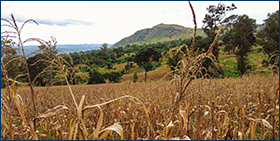El Niño, a threat to global agriculture

The El Niño weather phenomenon, which is due to return in the 2 nd half of 2023, is set to amplify the effects of climate change. The Indian-Pacific region is likely to experience severe heat and drought from Q4 onwards, and the impact of El Niño on the agricultural sector will be particularly visible in 2024, as commodity yields are highly dependent on weather conditions (heat, rainfall).
Coface's forecasts point to major uncertainties for certain agricultural commodities (cereals, sugar, palm oil, citrus fruit) in the medium term, and significant risks for food security in certain regions of the world.
The El Niño Southern Oscillation is an oceanic-atmospheric phenomenon whose origins lie in abnormal variations in surface water temperatures in the Central and Eastern Pacific (Latin American coast). It comprises two opposing phenomena (La Niña and El Niño) that historically occur every 2 to 3 years. La Niña brings colder, wetter weather, while El Niño brings warmer, drier weather.
The ongoing El Niño is occurring less than a year after the last La Niña episode, so much quicker than historical frequencies. This suggests and increase in the frequency of this type of weather phenomenon, which can have damaging consequences in the long-term. Indeed, El Niño weather disturbances, which affect the entire Indo-Pacific region, lead to heat waves and droughts. El Niño thus tends to amplify the negative effects of climate change in Asia-Pacific, South and East Africa and the Americas. Europe, the Middle East and North Africa are spared by the phenomenon.
Key regions for global agriculture and agri-food value chains under pressure
Brazil (the world’s leading producer of sugar cane, soya, coffee and oranges), India (world #2 producer of rice, wheat, sugar cane and potatoes), Indonesia (#1 producer of palm oil, #3 producer of rice) and Australia (world #4 producer of barley and rapeseed) are likely to be particularly exposed, and will see their agricultural yields fall.
Poorer harvests will put pressure on agri-food value chains as a whole, and 2024 is likely to be a year of extreme tension between supply and demand for the sector. Indeed, disruptions will have a negative impact on the production of both the major exporting countries (Australia, Brazil, US) and the demographically hot spots that are supposed to be self-sufficient in food (China, India). The pressure on supplies will therefore be twofold.
Unsurprisingly, food prices are set to rise in 2024. The example of South-East Asia is a relevant illustration of this. Various El Niño episodes in the last 20 years have generally led to inflationary pressures on food prices in the region. Rice, which accounts for 60% of domestic cereal consumption in the region, is very vulnerable to the effects of El Niño, while its water-intensive crop is likely to suffer from low levels of rainfall. Furthermore, the weight of food in regional consumer price indices is significant (around 40%), raising fears of a surge in inflation in the medium term.
Supply difficulties and rising food prices increase the risk of social & political instability in emerging economies.
Countries where the agricultural sector is predominant could suffer significant losses of income and employment. For instance, Indonesia, where agriculture accounts for 13% of GDP and 32% of jobs, could be hit hard by the negative impact of El Niño on rice and palm oil production. In the medium term, the country faces major political deadlines: the next general Indonesian elections (presidential, legislative and senatorial) are scheduled on February 2024. The economic difficulties caused by the uncertain weather conditions could therefore have a major impact on the country's stability.
On the other hand, exporting countries less affected by weather disruptions could benefit from higher prices of agricultural commodities.




